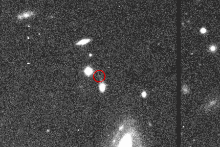 S/2003 J 2 imaged by the Canada-France-Hawaii Telescope during follow-up observations in February 2003 | |
| Discovery [1] | |
|---|---|
| Discovered by | Scott S. Sheppard et al. |
| Discovery site | Mauna Kea Obs. |
| Discovery date | 5 February 2003 |
| Orbital characteristics [2] | |
| Epoch 17 December 2020 (JD 2459200.5) | |
| Observation arc | 16.42 yr (5,996 d) |
| Earliest precovery date | 11 December 2001 |
| 0.1373976 AU (20,554,390 km) | |
| Eccentricity | 0.2776569 |
| –1.65 yr (–602.02 d) | |
| 114.43587° | |
| 0° 35m 52.742s / day | |
| Inclination | 149.20392° (to ecliptic) |
| 50.46976° | |
| 224.95527° | |
| Satellite of | Jupiter |
| Group | Ananke group |
| Physical characteristics | |
Mean diameter | ≈2 km[3] |
| Albedo | 0.04 (assumed)[3] |
| 23.2[3] | |
| 16.7[2] | |
S/2003 J 2 is a retrograde irregular satellite of Jupiter. The moon was discovered on 5 February 2003 by a team of astronomers from the University of Hawaii led by Scott S. Sheppard and David C. Jewitt, and was later announced on 4 March 2003.[4][5] It was initially thought to be Jupiter's outermost known moon until recovery observations disproved this in 2020.[6]
S/2003 J 2 is about 2 km (1.2 mi) in diameter, and orbits Jupiter at an average distance of about 20,600,000 kilometers (20.6 gigametres (0.138 AU)) in roughly 600 days, at an inclination of around 149° to the ecliptic and with an eccentricity of 0.28. The moon was initially assumed to be part of the Pasiphae group, but is now known to be part of the Ananke group after it was recovered in 2020.[1][6]

The moon was considered lost[7][8][9][10] until 2020, when it was recovered by Sheppard and independently by amateur astronomer Kai Ly.[6] The recovery of the moon was announced by the Minor Planet Center on 26 January 2021.[2]
References
- 1 2 MPEC 2003-E11: S/2003 J 1, 2003 J 2, 2003 J 3, 2003 J 4, 2003 J 5, 2003 J 6, 2003 J 7 2003 March 4 (discovery and ephemeris)
- 1 2 3 "MPEC 2021-B134 : S/2003 J 2". Minor Planet Electronic Circular. Minor Planet Center. 26 January 2021. Retrieved 26 January 2021.
- 1 2 3 S.S. Sheppard (2019), Moons of Jupiter, Carnegie Science, on line
- ↑ IAUC 8087: Satellites of Jupiter 2003 March 4 (discovery)
- ↑ Sheppard, Scott S.; Jewitt, David C. (2003). "An abundant population of small irregular satellites around Jupiter" (PDF). Nature. 423 (6937): 261–263. Bibcode:2003Natur.423..261S. doi:10.1038/nature01584. PMID 12748634. S2CID 4424447. Archived from the original (PDF) on May 15, 2006.
- 1 2 3 Hecht, Jeff (2021-01-11). "Amateur Astronomer Finds "Lost" Moons of Jupiter". www.skyandtelescope.com. Sky & Telescope. Retrieved 2021-01-11.
- ↑ Beatty, Kelly (4 April 2012). "Outer-Planet Moons Found — and Lost". www.skyandtelescope.com. Sky & Telescope. Retrieved 27 June 2017.
- ↑ Brozović, Marina; Jacobson, Robert A. (9 March 2017). "The Orbits of Jupiter's Irregular Satellites". The Astronomical Journal. 153 (4): 147. Bibcode:2017AJ....153..147B. doi:10.3847/1538-3881/aa5e4d.
- ↑ Jacobson, B.; Brozović, M.; Gladman, B.; Alexandersen, M.; Nicholson, P. D.; Veillet, C. (28 September 2012). "Irregular Satellites of the Outer Planets: Orbital Uncertainties and Astrometric Recoveries in 2009–2011". The Astronomical Journal. 144 (5): 132. Bibcode:2012AJ....144..132J. doi:10.1088/0004-6256/144/5/132. S2CID 123117568.
- ↑ Sheppard, Scott S. (2017). "New Moons of Jupiter Announced in 2017". home.dtm.ciw.edu. Retrieved 27 June 2017.
We likely have all of the lost moons in our new observations from 2017, but to link them back to the remaining lost 2003 objects requires more observations a year later to confirm the linkages, which will not happen until early 2018. ... There are likely a few more new moons as well in our 2017 observations, but we need to reobserve them in 2018 to determine which of the discoveries are new and which are lost 2003 moons.